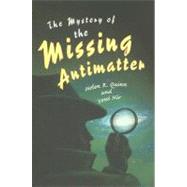
What is included with this book?
| Acknowledgments | p. xi |
| Prelude: The Mystery of the Missing Antimatter | p. 1 |
| Constant Physics in an Evolving Universe | p. 7 |
| Universal Laws | p. 7 |
| Hubble and the Expanding Universe | p. 8 |
| Red-shifts: Evidence for an Expanding Universe | p. 12 |
| Numbers Large and Small | p. 17 |
| What Do We Mean by "Universe"? | p. 19 |
| As the Universe Expands | p. 21 |
| Running the Clock Forward: Radiation | p. 21 |
| Running the Clock Forward: Dark Matter | p. 26 |
| Running the Clock Forward: Light Nuclei | p. 29 |
| Running the Clock Forward: Matter and Antimatter | p. 32 |
| What Is Antimatter? | p. 36 |
| What Is Matter? | p. 36 |
| Dirac Introduces Antimatter | p. 42 |
| Experiments Confirm That Antimatter Exists | p. 45 |
| Radioactive Decays of Nuclei | p. 48 |
| Enter Neutrinos | p. 51 |
| Pauli: The Beta Decay Puzzle | p. 51 |
| Fermi: The Theory of Neutrinos Develops | p. 53 |
| Cowan and Reines: Neutrinos Detected | p. 55 |
| Mesons | p. 57 |
| Yukawa and the Pi-Meson | p. 57 |
| Strange Mesons, Strange Quantum Concepts | p. 61 |
| Through the Looking Glass | p. 63 |
| A Gedanken Experiment | p. 64 |
| The Actual Experiment | p. 67 |
| Through the Looking Antiglass | p. 73 |
| Another Gedanken Experiment | p. 73 |
| Cronin and Fitch: Matter and Antimatter Do Not Follow the Same Laws | p. 75 |
| The Survival of Matter | p. 80 |
| Pauli's Other Letter: Initial Conditions on the Universe | p. 80 |
| Sakharov: The Conditions Needed to Develop an Imbalance | p. 84 |
| Cosmology with Sakharov's Conditions Met: Baryogenesis | p. 88 |
| Enter Quarks | p. 91 |
| Quarks | p. 91 |
| Why Don't We See the Quarks? | p. 96 |
| What about Dark Matter? | p. 100 |
| The Missing Charm, the Surprising Tau | p. 101 |
| The Standard Model: Particles and Interactions | p. 107 |
| Energy Rules | p. 111 |
| Stored Energy, Forces, and Energy Conservation 111 | |
| Force Fields Permeating Space | p. 114 |
| Field Theory and the Energy Function | p. 116 |
| Symmetry Rules | p. 121 |
| Symmetries as Answers to the Question "Why?" | p. 121 |
| Symmetries and Conservation Laws | p. 123 |
| Space-Time Symmetries | p. 124 |
| Gauge Symmetries | p. 126 |
| Discrete Symmetries | p. 128 |
| Baryon and Lepton Number Conservation? | p. 130 |
| Standard Model Gauge Symmetries | p. 132 |
| The Symmetry behind the Electromagnetic Interaction | p. 132 |
| The Symmetry behind the Strong Interaction | p. 134 |
| The Symmetry behind the Weak Interaction | p. 137 |
| A Missing Piece | p. 140 |
| The Puzzle of Particle Masses | p. 140 |
| How Do We Describe Nothing? | p. 146 |
| At Last, CP Violated in the Standard Model | p. 153 |
| It Still Doesn't Work! | p. 159 |
| Running the Clock Forward: The Standard Model | p. 159 |
| Now What? | p. 163 |
| Tools of the Trade | p. 168 |
| Accelerators | p. 168 |
| Detectors | p. 172 |
| Data Handling and Analysis | p. 177 |
| How Projects Develop | p. 178 |
| Searching for Clues | p. 180 |
| Where Are We Now? | p. 180 |
| Testing the Standard Model in B-Meson Decays | p. 182 |
| Oddone: How to Build B Factories? | p. 184 |
| Running the B Factories: The First Test | p. 190 |
| Speculations | p. 194 |
| Why Are We Never Satisfied? | p. 194 |
| Grand Unified Theories | p. 195 |
| Supersymmetry | p. 201 |
| Way beyond the Standard Model | p. 204 |
| Neutrino Surprises | p. 206 |
| Davis, Bahcall, Koshiba: Solar Neutrinos | p. 206 |
| Quantum Neutrino Properties | p. 214 |
| Following the New Clues | p. 222 |
| Some Things We Know | p. 222 |
| Some Things We Speculate About | p. 225 |
| Fitting It All Together | p. 227 |
| Finale | p. 231 |
| Timeline of Particle Physics and Cosmology | p. 233 |
| Perspective | p. 233 |
| Relevant Nineteenth-Century Developments | p. 234 |
| 1900-1930: Development of Quantum Ideas, Beginnings of Scientific Cosmology | p. 238 |
| 1930-1950: New Particles, New Ideas | p. 245 |
| 1930-1960s: The Advent of Accelerator Experiments--The Particle Explosion; Implications of Expanding Universe Explored | p. 249 |
| 1964-1973: Formulation of the Modern View of Particles and the | |
| Table of Contents provided by Publisher. All Rights Reserved. |
The New copy of this book will include any supplemental materials advertised. Please check the title of the book to determine if it should include any access cards, study guides, lab manuals, CDs, etc.
The Used, Rental and eBook copies of this book are not guaranteed to include any supplemental materials. Typically, only the book itself is included. This is true even if the title states it includes any access cards, study guides, lab manuals, CDs, etc.